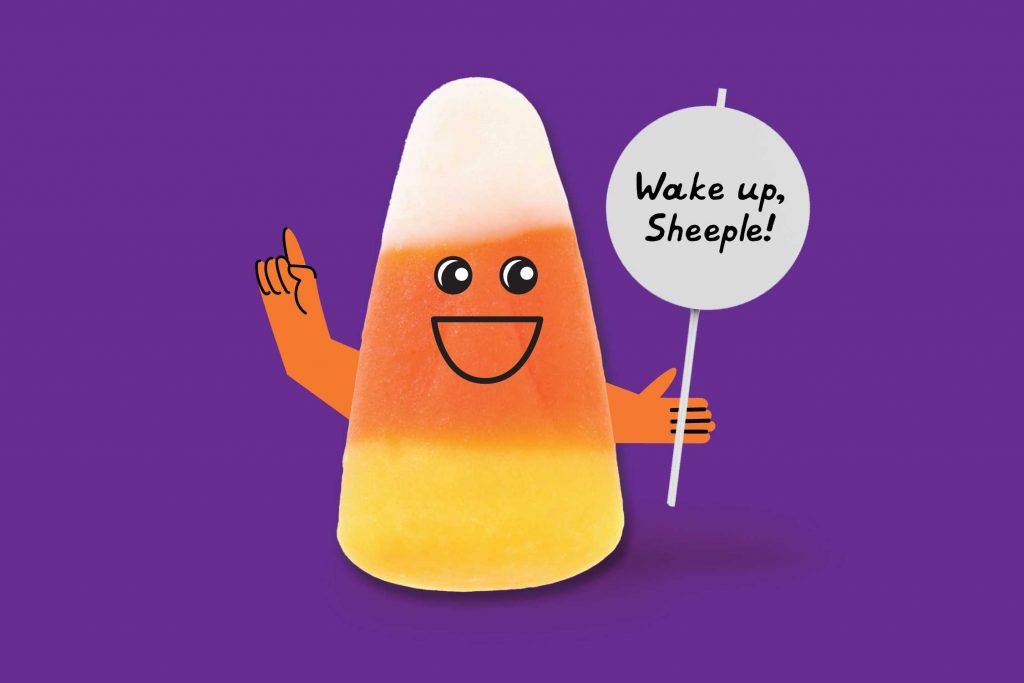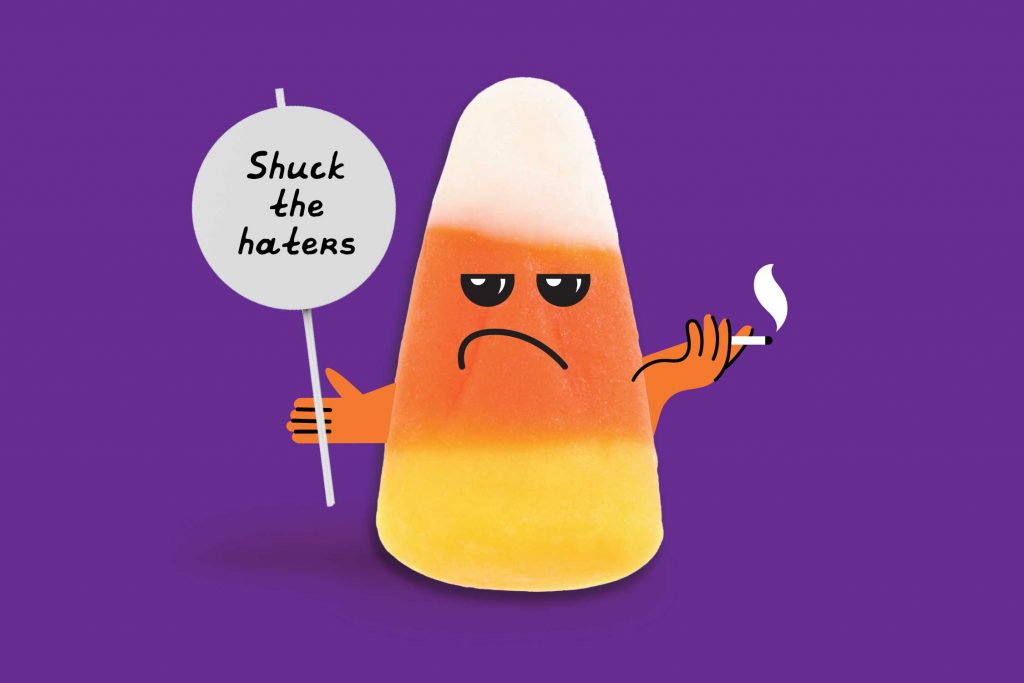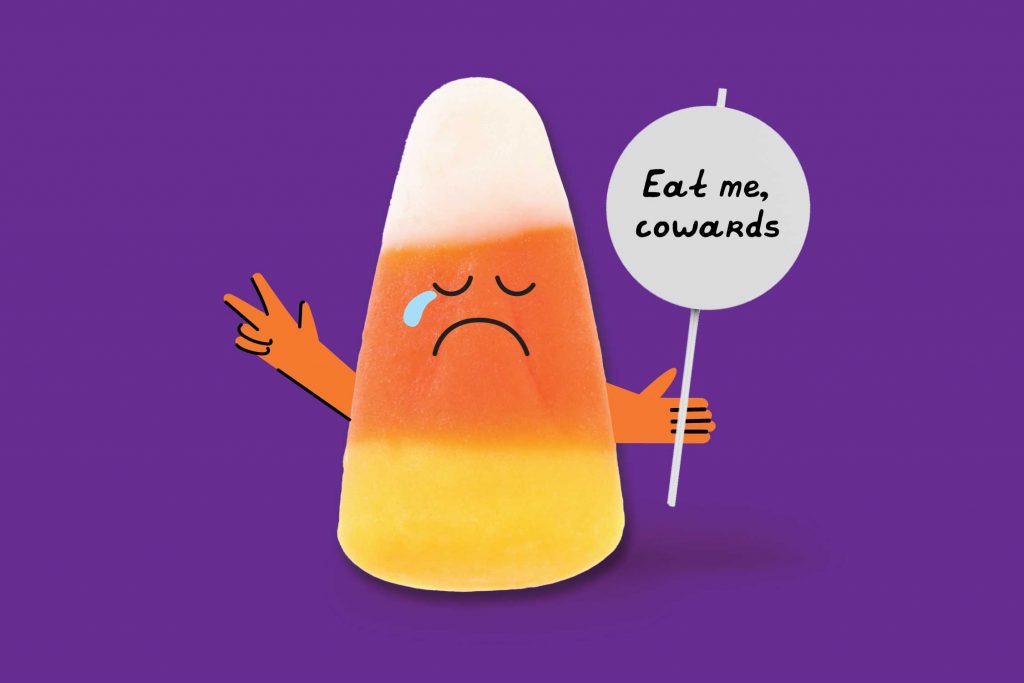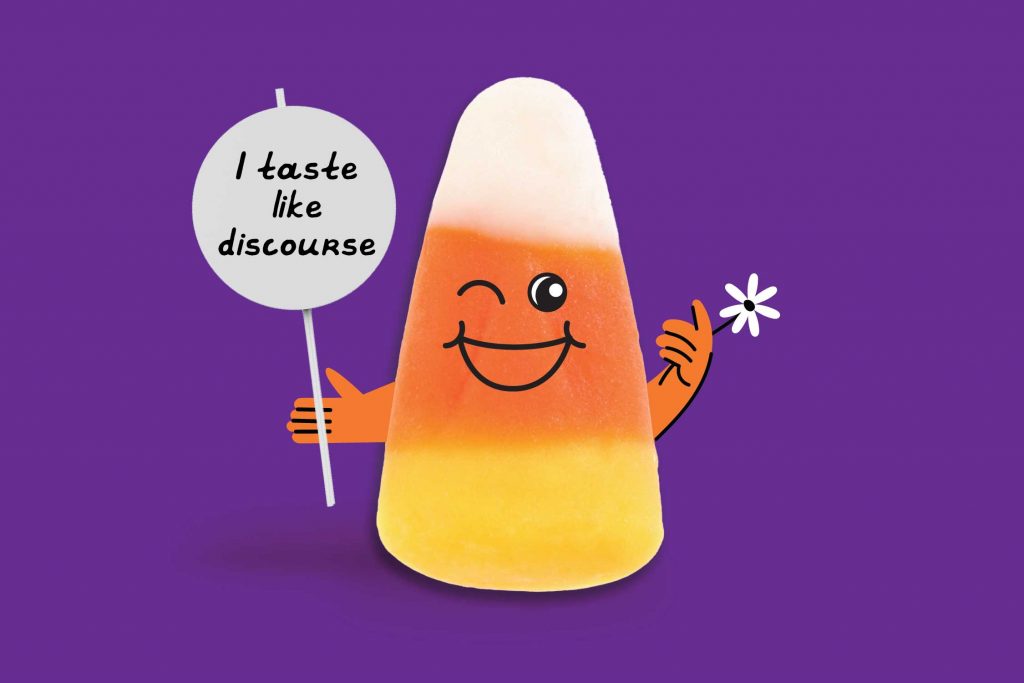
As the end of October approaches, the month’s penultimate holiday takes center stage, where those who celebrate carve pumpkins, throw parties, and eat candy with the vigor of an undead Swiftie.
Unlike some of the other low-stakes American holidays on the calendar, All Hallows’ Eve totes along with it an icy trail of outrage and discourse over candy stemming from decades of pointed marketing and straight-up propaganda.
Today, we are talking about (to the surprise of literally no one in my inner circle) candy corn.
From the drugs-laced candy bars to apples supposedly stuck with razor blades, the national panic caused by trick-or-treating is as intrinsic to Halloween as Bobby “Boris” Pickett’s 1962 graveyard smash, “Monster Mash.” Love it or hate it, there is no confection with a stronger Halloween connection than candy corn.
Why the hate? Why is it so hard to shake off the antiquated thought process of “you can only eat this thing on that holiday” when said food is delicious and available at any grocery store roughly 91% of the fiscal year?!
Stop what you’re about to say. Consider this: your brain (coupled with the mainstream media) has tricked your body and the larger population into disliking an objectively delicious candy.
Mudge Hot Take: candy corn is delicious and you should eat it all year, cowards!

WhaaaAAAaaat’s the deal with candy corn?
Ask a group of people what they think about candy corn and you’ll get a mixed bag of responses. Amongst the diehard candy corn eaters and fairweather snackers, you’re guaranteed to find a couple of folks who view the stuff like poison.
Candy corn is a holiday treat — a particularly old-timey holiday treat with a divisive reputation on par with fruitcake, figgy pudding, marshmallow Peeps, and those Godless orange circus peanuts that materialize around Easter.
Amongst the most common reasons people say hell no to candy corn? Your laundry list of excuses typically includes:
- Weird texture
- Too sweet
- Halloween is 9 months away, dummy!
I’m sorry, but I thought this was America! Land of two sets of rules: none and your own.
It’s so unlike us Americans to follow antiquated rules so closely. One could argue it’s intrinsic in our DNA to say “thanks, but no thanks” to the culinary traditions and expectations expected of us when holidays happen. To get to the bottom of the discourse, we need to go back to a time.
At the end of the 19th century, America’s labor force was primarily made up of farmers. As such, candy brands like Goelitz Confectionary Company (now known as The Jelly Belly Candy Co.) would release agriculture-shaped penny candies for children in farming communities.
Sold in a rooster-emblazoned box as “chicken feed” with the tagline “Something worth crowing for,” candy corn became the popular penny candy during a time when a kid’s whole life was waking up at dawn to feed the pigs and playing that old-timey hoop and stick game.
Back then, producing candy corn was a slow, labor-intensive process, with most candy being manufactured only between May and November. Voila – perfectly timed for Halloween. Now, 35 million pounds of candy corn (omfg, more than nine billion pieces) are produced yearly.
So, why all the hate? In a 2021 story on USA TODAY called “Candy corn: The Halloween candy that divides a nation. Its original name? ‘Chicken feed‘”, senior editor at Cook’s Illustrated Magazine, Paul Adams, pontificated the controversy behind this innocuous treat comes down to its uniform taste.
“From a sensory perspective,” started Adams, “the hatred of candy corn can be explained because, unlike many candies, its flavor profile doesn’t incorporate contrast.
It could also be the bug secretions. Yep! Bugs!
Abbey Thiel is a writer, blogger, and food scientist by Ph.D. whose holistic understanding of candy corn comes from a technical background and offered some context on the growing divide between candy corn and candy-corn-consumer.
“I hate to tell you this,” says Abbey, “but I am a hater of candy corn.” Strike one. Abbey came prepared with a list of common candy corn ingredients.
“Obviously there’s sugar, corn syrup, shellac….”
“Shellac as in what you apply on tables?” I asked.
“Yep. shellac is a polishing or glazing agent in a lot of food. So it’s sprayed on the surface of many candies – Junior Mints, Raisinettes, Whoppers, things with a glean.” But it gets a lot of grief because shellac is a bug-derived ingredient. So people will blow it up and say, there’s bugs in your candy corn. Which, like, yeah. Food is grown outside.”
Nooooo…
“Yes, you’re eating buggy parts all the time. It comes from this bug that infests trees called the female lac bug on trees in the forests of India and Thailand, which secretes shellac resin to protect its larva. And so we take that shellac, purify it, and ensure it’s food grade before it goes in candy.”
So, yes, candy corn’s trademark gleam comes from a bug, but that does not mean that whole bugs are put in the candy corn.
“It’s such a crappy texture,” adds Abbey, “like, no flavor. What is it even supposed to be? I remember coming home from [trick-or-treating] and thinking candy corn was the worst candy in my pumpkin.”

What do you like?
Abbey made a point I can’t shake out of my head. There are bug parts in a lot of what we eat and drink. Ever tried honey? Bee puke.
Catskill Provisions’ Crimson Amaro is a bright, herbaceous spirit made with juniper, wormwood, sage, angelica, gentian, and orris root that’s naturally colored with cochineal – a red dye made from the small, wingless insect of the same name.
These days, you can find bug-based snacks like cricket flour, cheesy meal worms, cotton candy critters, and dates – which I regret to inform you can often be home to worms and spiders. Bugs are everywhere, so it’s gotta be the taste.
To me, candy corn tastes like cake frosting – in the shape of a corn kernel. It’s smooth and creamy with an aftertaste that keeps you returning for more. Sure, I’m technically eating a mama bug’s defense system for its kids, but the taste doesn’t lie.
Why don’t you like candy corn? Is it the taste/texture? Do you let the bug thing get to you? How many popular treats out there are made of literally 100% sugar? Cotton candy, caramel, cake frosting… would you still eat a piece of cake if it wasn’t your birthday?
From a branding standpoint, candy corn’s enduring legacy should be viewed as a lesson in tenacity. The desire to be all things to all people goes deep, but it shows when a brand tries too hard to appease different tastes.
You just can’t make everyone happy.
Former Global Program Director of R&D for Ben & Jerry’s and candy corn appreciator Arnold Carbone knows this more than anyone. The famed flavor guru knows what people want in a pint, spending more than two decades churning out new and exciting flavors for the iconic brand.
Arnold’s team was tasked with taking on flavors considered too expensive or risky at Ben & Jerry’s, personally spearheading such wildly popular flavors as Chubby Hubby, Phish Food, Peanut Butter Cup, the “Original” Core Concoction line, and of course Wavy Gravy.
“You know those orange circus peanuts?” asks Arnold, “well, there’s a flavor note in those — bananas — that when we were testing Chunky Monkey, some people said it reminded them of circus peanuts.
I abhor circus peanuts. Taste, color, and texture they make a mockery of the real thing. I couldn’t help but wonder: is my propensity toward candy corn just the different side of the same coin? Will the diehard circus peanut fans please stand up? Do you people even exist?
When it comes to candy corn, Arnold’s hot take is lukewarm.
“Oh yeah, I liked candy corn,” says Arnold. I remember I’d stick them on my teeth like a vampire and scare the kids on Halloween! I didn’t really keep it around the house after that.”
Arnold’s encyclopedic knowledge of all things flavor is his superpower. Starting at Ben & Jerry’s as a scooper, it was his keen sense of taste (and, yes, managerial skills) that earned him the unofficial title of Conductor of Bizarre & D.
“Candy corn has an interesting flavor profile: almost like toasted marshmallow. If you pinch your nose while eating it, you notice a prominent vanilla. If you think about what it smells like when you walk into a donut shop or bake cookies, it’s the vanilla.”
Arnold is, in some ways, a dessert purist. Big flavors can’t flourish if they’re done half-assed or for publicity. Some flavors need to stay in their lane.
“Everybody has their personal preferences,” adds Arnold. “My opinion is very distinct flavor profiles, that don’t taste like anything else, are more polarizing, and some people won’t touch them, hence, no mint candy corn or wasabi Peeps. Food companies need to stay loyal to what’s worked for them over the years when it comes to product recipes and flavor profiles. Candy corn [standing] the test of time has less to do with flavor and more so because it’s an ‘eye-catching,’ nostalgic, seasonal, inexpensive product for food producers to put on the shelf to launch a season. As my late mother would say, ‘a word to the wise’ don’t mess with the Candy Corn.”

Candy corn follows two sets of rules: none and its own. This Halloween (and every month after), we invite you to forget everything you knew about candy corn. Forget about context; don’t stress on the shellac, just put a bunch of candy corn in your mouth.
Remember that inside, every brand is dying to be candy corn: a rebellious blowhard with the dignity and tact of an old-timey steamboat captain. Candy corn doesn’t give one shellacked shit what the critics say. It is unapologetic, it is unabashedly unique, and it is a small percentage of bug excretions, but who cares??
Don’t be afraid of candy corn.
